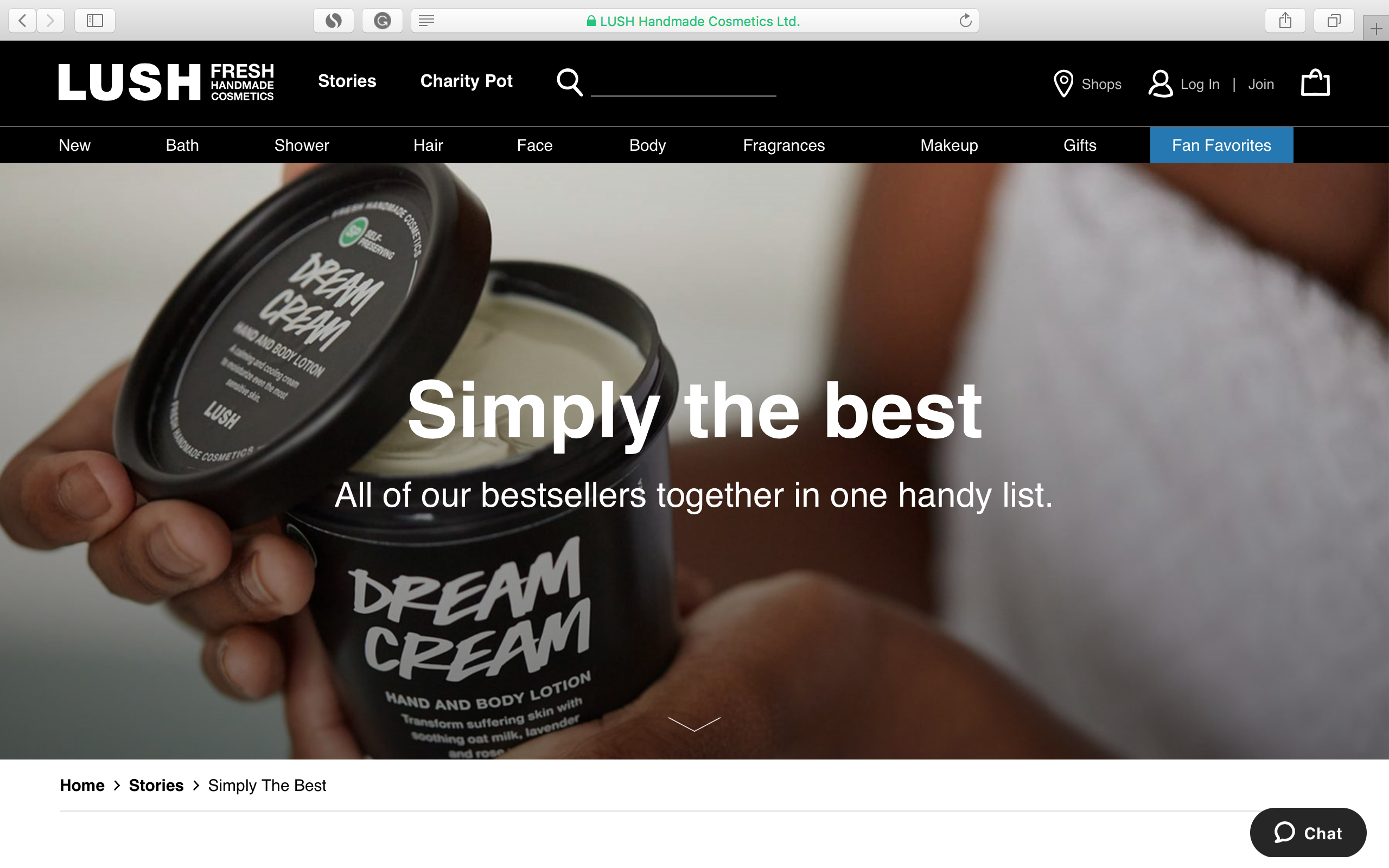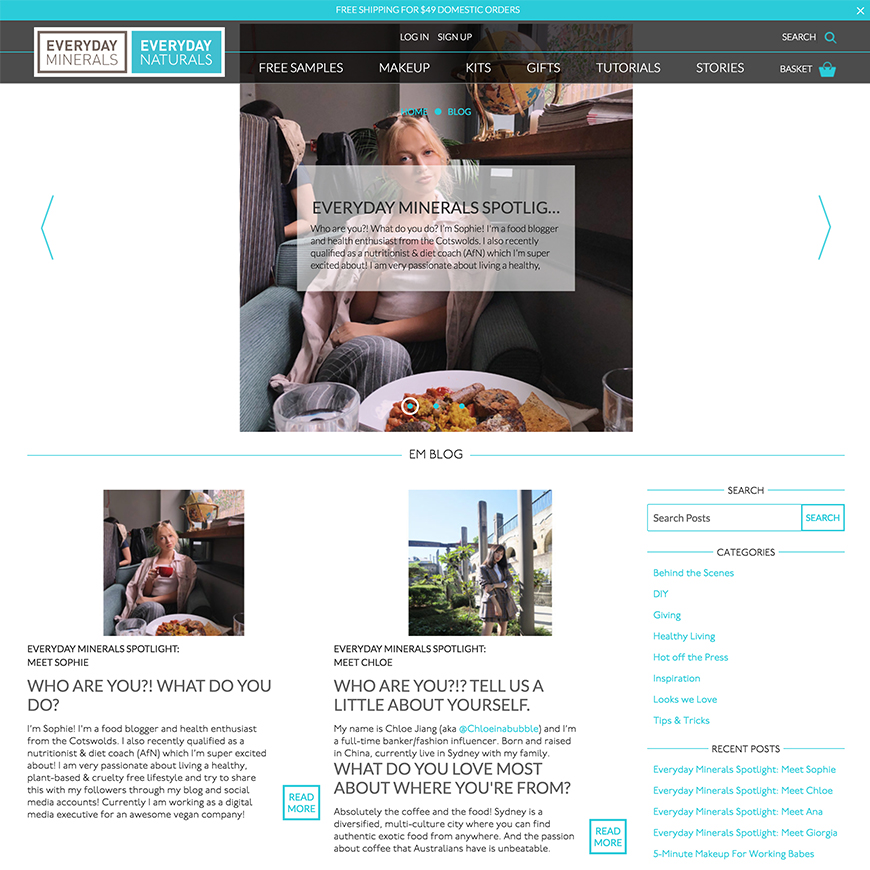Why blog on an eCommerce site?
Informative, entertaining, engaging and... a key revenue source! These are just some of your expectations, right?
If you’ve ever thought about starting a business blog, but haven't done it yet, it’s a hight time to reconsider. eCommerce blogging will help you to drive more traffic to your store. With more traffic, you have better chances of growing your sales.
In this post, you’ll learn why you should start a blog on your eCommerce site, where you can find blog post ideas as well as many other necessary blogging tips.

Blogs have been named the 5th most trusted source for accurate online information. (HubSpot, 2015)
Firstly, let's dive into the main reasons why to blog.
How to use your blog? What for?
📢 Tell your story + give your brand a voice
One of the key roles of any eCommerce blog is to be your own media scene where you can talk about your company and promote your brand.
Your blog is the best space to show what your business is about by sharing content you find relevant and interesting, demonstrating your products in action or highlighting founders, employees or customers.
Usually, customers visiting your online store are interested to get more information about the products (or services) they gonna buy from you. Consequently, your blog should include not just pure marketing staff, but provide potential consumers with the effective business content.

Source: PANDORA
In a blog post, you can show how to use a product and why people should buy it. You can also tell your audience about yourself and your company. And you'll be able to tell the story of your products from your perspective.
Finally, content marketing has always been about storytelling. The more your audience knows and likes about you, the more likely they are to buy from you.
💭 Engage customers + communicate with your audience
You want your audience to remember you, even when they’re not going to buy anything just now?
Instead of having a website where customers only make purchases, you can take advantage of your blog as a method of engaging site visitors on a continuing basis . Give your customers what they want and they will for sure come back for more.



Source: NASTY GAL
Most blogs have a comment section, enabling you to collaborate, share and engage with people. Such interaction makes your readers feel as if they are from among a large club of brand lovers and thus you can build the community of regular visitors and contributors to your site. Thus, your customer can become your product advocate by sharing blog posts and thus popularizing your business at no charge. Provide customers with something fun and fresh for them to make a pitch for your business.
Don't worry about spam, negative feedback or awkward questions, cause you can manage your blog in such a way that you'll be able to approve the outsides comments before they go live.

94% of people who share posts do so because they think it might be helpful to others. (Semrush, 2016)
And, of course, make sure that you engage and reply to people that are commenting on your blog – it shows that you care and will stimulate debate. In turn, this encourages others to do the same.
If you blog on a regular basis and post your blog posts on social media, you’ll stay top of mind of your audience and your blog is becoming your own PR and communications tool.
💙 Build brand loyalty + stickiness
Even though you do have the best product in the world, the number of repeat customers is still likely to be low, unless you build brand loyalty.
We all know, as consumers ourselves, once we find a store we like, we are more willing to return to that store than go someplace similar.

For sure, your blog will not build brand loyalty alone, but it plays a major part in the process. Whether you provide relevant, professional, informative and fun content, it will help to build the loyalty.
🔝 Support SEO + drive website traffic
Show me a business that doesn’t want better rankings in search engines, or more website visitors.
One of the pillars of SEO is content. A blog is a great way to add new and relevant content to your website, but don't forget to update your existing pages as well.

55% of bloggers update old content. (SnapApp, 2017)
Your blog gives you the opportunity to talk in detail about topics that interest your audience.
When creating blog posts, you can include external and internal links, images, video and so on. If optimized and done correctly, this helps your SEO efforts by sending out all the right signals to search engines.
Working hand in hand with social media as a means for distribution and sharing, your blog can become a major source of traffic.
Blogging makes it easier for new visitors to find you and gives a reason for previous visitors to keep coming back.

So, blogging definitely brings an additional traffic and ensures a drastic increase in revenue.
And more great news – now you can pay less to your digital PPC agency!
But how do you know what are today's blog ranking tactics, what matters and what doesn't while blogging? You should keep in mind these SEO tips on how you can optimize your blog posts for the highly relevant keywords.
💪 Strengthen SMM efforts
Any blog post has a unique URL, that can be shared via social media profiles. "Like" and "Share" buttons can be added to your post to achieve more followers and fans on social media and strengthen SMM efforts.

💸 Drive sales and long-term growth…
A blog is unlikely to transform your sales overnight. However, once you’ve started to get some traction in terms of SEO, social media and website traffic, you can use your blog to generate sales leads.
Not every reader will become a lead, but those that do can be marked as warm (already receptive).

Finally, as a combination of other points, you should be looking at blogging as a potential driver for long-term business growth.
A great blog post is an investment that will bear fruit for many months, or even years, down the line.
... and it's a powerful form of 🆓 marketing!
Your blog is kind of a highly efficient form of free marketing, regardless of your marketing budget.
Though, it would be incorrect to say that blogging is free. There’s a huge opportunity cost associated with blogging – and you may eventually have to hire a team of writers to handle things or pay for promotion of some of your posts – but it’s comparatively cost effective, as each post will drive organic traffic.
And blogging is easy. It's easy to start a blog. But that isn’t so easy is having a content strategy and blog plan.
You can write about all kinds of things on your blog, but make sure to do proper keyword research first. You need to know what search terms you want to be found for. These keywords should be leading when you choose what to blog about. A keyword, however, is not a topic yet. You need an angle, a story around such a keyword.
One of the biggest challenges to starting your business blog is making sure you can create enough content to keep it going.
As for topics, the following should help you get started:
1 Industry Trends and News
Talking about your company is great, but talking about your industry is even better. Think beyond your little company world and talk about what’s happening in your industry. Every industry has trends, although some are more obvious than others. If you aren’t able to spot these trends in advance, it is always best to create a post when you do become aware of them, making sure you feature any of your products that relate to it.
Showing your audience that you are up-to-date on all things related to your industry shows them that you know what you’re doing/talking about.
2 Company History and News
Talk about your company. How was it founded? What’s your vision for the future?
Source: Two Blind Brothers
You can mention any figures, awards, something is worth talking about.
A simple update on what’s going on in your company is always a good blog post. People love to feel like they have a sneak peek behind the curtain with your company, so including them on what the latest news is. You even can showcase your office space and employees once in a while is great for that.
Talk about what’s in the works to get them excited.
3 Product Review
Another powerful story you can tell your readers is how your product benefit people.
Highlight one of your products. Pour out how it works and how it was made (from which materials, by whom, etc.).
You even can create a series of posts showing how a product goes from concept through to production, photography and finally being posted on the website. Or, alternatively, you could also create an in-depth super-review of one of your best-selling products.
Seeing is believing, that's why seeing how the product works and causes changes can turn a person from a skeptic into an advocate.
4 Product Launches + Announcements
It’s always important to inform your customers of things happening on your website such as new season products, sales and other promotions.

Source: Apple
Loyal customers probably will love to know about new products before they are for sale and it's a great opportunity to heighten people’s interest in you and your product. If you sell your own products, you can show design sketches or show examples of the materials you gonna use for manufacturing.
Product launch day is not the only one day you share the news with your customers. Don't forget to brief on product upgrades and improvements as well as shout out from the roofs about special offers, discounts and deals ! People are crazy about them!
5 Tutorials
You can offer product guidance or answer FAQs, but it’s more beneficial to show how to use the products you offer and do it in casual format.
Don’t assume that your customers know how to use the product. Creating “How-To” videos gives customers inspiration on different ways to use it through your blog content.

Source: United Colors of Benetton
Some helpful tips concerning your product will show blog readers that you really are the expert in your field and you do care about your customers.
6 Lists
People like content that’s easy to skim with subheadings and numbers.
Creating lists is a great way to get out a quick blog post. They also make great traction because people can skim them easily. Don’t hold back; make it as in-depth as possible with examples as well as visuals. Really show off what you know!

43% of people admit to skimming blog posts. (HubSpot, 2018). Here you can check some examples of super skimmable content.

Source: LUSH
7 Infographics
People love images and statistical data.

Infographics can increase web traffic by up to 12%. (HubSpot, 2018)

Source: Samsung
8 Content from customers
Listen carefully and your customers will tell you what they want. Also, consider listening to online chatter by searching social networks like Twitter for people discussing the products you sell.

Source: Everyday Minerals
· FAQs into a post
Do you get asked the same question over and over again? If so, why not put the answer on your blog?
Answering questions in the form of blog posts is a great way to get content that you know your customers are interested in as they are asking about it. And, sometimes this will help to cut down on customers repeatedly emailing or phoning you and asking the same questions.
NOTE: You can use unanswered questions on your competitor’s blog as an idea for your next post.
· Customer review
You don’t always have to be the one writing the post — ask one of your most trusted and loyal customers to write an in-depth product review for you. Offer an incentive by giving them the product for free or even a gift voucher for a future purchase.

Source: Fitbit
People like being mentioned on the site and see themselves in testimonials or case studies. Thus, making reference to your diverse customers is a great way to show your new leads they are pretty similar to your current customers.
9 Guest Posts from Experts

Guest posting services and strategies gained 112%increased in interest since 2005 and it remains at an all-time high since 2013.(Websites That Sell)

Source: LEVI'S
You may think you know a lot about a particular subject, but there is always someone else who knows then you. Find some experts in your industry who can share their advice on subjects you are less familiar with.
10 Seasonal Posts + Holidays
Each season will see a spike in seasonal searches. Think about how the seasons may affect your customers and how they use your products.

Source: ALOYOGA
11 Competitions, prize draws, giveaways
Everybody loves freebies and you’ll be surprised by how many people will work for it.
While telling about one lucky reader who got your prize/giveaway, you can let the whole audience know about product’s benefits! This will encourage more of your readers to actually interact with you, but don’t waste this opportunity, once the competition is over make sure you keep interacting with them.

Source: boohoo
12 Jokes, memes, fun stories...
Something fun you found on the web. It could but doesn’t have to relate to your products.
You can choose any topic for your blog post. Don’t feel limited!
Be SOCIALLY RESPONSIBLE!
Don’t forget to highlight your community and charity involvement in your blog posts, as customers like to support businesses who are connected to something larger than themselves.
Source: H&M
So, you've got the idea...
The main goal of business blogging is to inform readers and entertain them. Your blog is about establishing your brand as a credible source in your field.
But, content is a challenge, especially if you can’t afford a special blogging guy.
Don’t worry. Check more awesome blog post ideas that are proven to work.
More tips from blogging experts you can find here and killer tools for business blogging here.
Conclusion
While purchasing online, Internet users care about who they are buying from. For that reason, business blog helps to show that your online store values clients' interests and needs. To put it another way, blog establishes credibility.
Combined with having your site rank higher and providing valuable information, with blogging on your eCommerce site, you make a presentation of your company and products what makes your customers come back for more. Thus, blogging will help to set your online store apart from your competitors.
In order to gain a following for your blog, you need to be sure you are producing content that is not only enjoyable to read, but also offers information that will keep your readers returning for more.
Top 10 Articles related to the topic:
1 How to Use a Blog to Increase Traffic and Sales of Your eCommerce Store
2 20 Simple Ways to Boost Blog Subscribers
3 Why Blog? The Benefits of Blogging for Business and Marketing
4 From the Experts: 18 Great Blogging Tips for 2018
5 Blogging Statistics and Trends: The 2017 Survey of 1000+ Bloggers
6 How Neil Patel Managed to Write 4294 Blog Posts
7 Blogging for Retail Stores. How and Why Retailers Should Blog
8 eCommerce content marketing: 3 Steps to start a blog and drive tons of traffic
9 The Importance of a Blog and How to Start One for Your Store
10 How to Create a Must-Read Business Blog
Do you a blog on your eCommerce site? Was it difficult for you to get started? How did you find the first idea for the first blog post?
We would love to hear your own experience of blogging. Please, share some tips in the comments section below!


